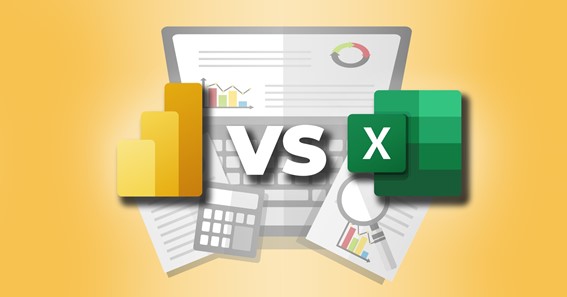In today’s corporate world, having tools that allow us to swiftly and intuitively evaluate data and translate databases into understandable information is critical. Data analysis is becoming more and more important to businesses as they realize its link to better performance and increased profits. As a result, selecting the best tool is critical if professionals get the most out of their work. Excel and Power BI are the two most widely used tools globally when it comes to analyzing data.
Knowing Power BI can help you land a job in data analysis or business intelligence. Power BI is the market leader and fosters analytical thinking for producing solutions when it comes to executing. A Power BI certification is a worthwhile investment for today’s job-seekers who want to advance their careers.
Let’s compare Power BI and Excel and consider a few crucial variables. We’ll start with an overview of each tool’s capabilities and advantages.
Introduction
Excel and Power Bi have many functional similarities, although Excel is considerably easier to use than Power Bi. At the same time, Power Bi offers several advantages, such as improved visualization and the ability to share reports, which Excel cannot accomplish.
- Complex data model
If you want to develop a complicated data model, Power BI can handle it, although Excel isn’t designed for it. Power BI Desktop’s drag-and-drop functionality and powerful filters make it possible to model data in a way that Excel does not allow.
- Data Security
You can restrict access to a file, worksheet, or workbook in Microsoft Excel. You can also make the files read-only so that no one can modify or change them. Data security in Microsoft Excel is limited to this feature. Security controls are not built-in, unlike in Power BI.
- Collaboration
Power BI makes it simple to invite others, provide access, and allow comments on dashboards. Thanks to its dashboard sharing feature, you may easily share dashboards with Power BI! It’s simple to work together on a Microsoft Excel online sheet with other people. You can also set up security and access permissions to guarantee that only those granted access to your spreadsheet may modify and view it.
- Language dependency
You can utilize the DAX (Data Analysis Expressions) language in Power BI instead of MDX (Microsoft Excel). With the help of DAX in Power BI, you may create unique datasets and do computations on your own.
- Data visualizations
Power BI beats out Microsoft Excel for data visualization thanks to a wide choice of charts like Tables, Area Charts, Doughnut Charts, Funnel Charts, and others that can efficiently examine large amounts of data. Personal dashboards give users a complete picture of their activities, reports, and data sets. It can create alerts based on Key Performance Indicators (KPIs) to warn you when a dashboard change exceeds the set limit.
- Reporting and dashboarding
Excel’s dashboards are limited in interaction and functionality compared to other spreadsheet programs. A tabular data format allows you to see data in various ways by using multiple charting options. However, it isn’t the best option for dealing with massive data. Easy formatting, natural language querying, scaling, editing, and filtering are just a few of Power BI’s powerful features that make reports easier to understand and more aesthetically appeal to while also allowing you to draw multi-faceted insights to help lead the decision-making process.
- Pricing
- Power BI offers a variety of price options:
- Cost: $9.99/user/month for Power BI Pro
- There are two options for Power BI Premium: a free plan and a paid plan.
- Power BI Pro capabilities are included in this package, costing $20 per month per user.
- Per Capacity: This plan, which costs $4,995 per month, is geared toward businesses of all sizes.
- If you only want Microsoft Excel, the price is $139.99, but you can get it for $6.99/month as part of the Office 365 Suite for the same amount.
- Automatic data updates
When the source data changes, Power BI automatically updates the data. As these changes are displayed in real-time, you and your team will always have the most current information. Live data updates are also available in Excel. However, power bi provides a broader range of possibilities. The process of updating Power BI reports may be made considerably easier by using subscriptions and dataflow!
- Reporting speed
Visualizations and automated updates make Power BI reports significantly more user-friendly. Power BI generates reports and dashboards rapidly, but Excel requires much work to set up computations and layouts for each report or dashboard. Excel is still a viable option if you have any data on a single sheet. However, Power BI’s lightning-fast reporting makes it an excellent choice for individuals who require reports and dashboards immediately.
Summarizing differences between Excel and Power BI
- Using Excel, you can organize and manipulate data and conduct various mathematical functions. The Power BI platform, on the other hand, was designed as a business intelligence and data visualization tool for corporations and organizations.
- There are limits to the quantity of data that Excel can handle. The amount of data that Power BI can manage is far more.
- In contrast to Excel, Power BI can connect to various data sources. In addition, Power BI can be used via mobile devices, unlike Excel.
- Power BI performs better than Excel in terms of speed.
- Visually beautiful, dynamic, and configurable dashboards in Power BI are superior to those in Excel.
- Comparing tables, reports, or data files using Power BI is more powerful than Excel.
- Power BI is more user-friendly and simple to use than Excel.
Closing thoughts
Even though both are Microsoft’s beautiful products, the present-day requires quick and easy data analysis. Excel isn’t going anywhere anytime soon, but Power BI has already taken over the dashboard-creating process for a significant quantity of data.
Power BI has a bright future ahead of it. Since many businesses now rely heavily on data visualization tools, it may be worth your while to spend some time and money learning how to utilize them. So, now it’s time to join a Power BI training program and become a Power BI superstar at your workplace.







